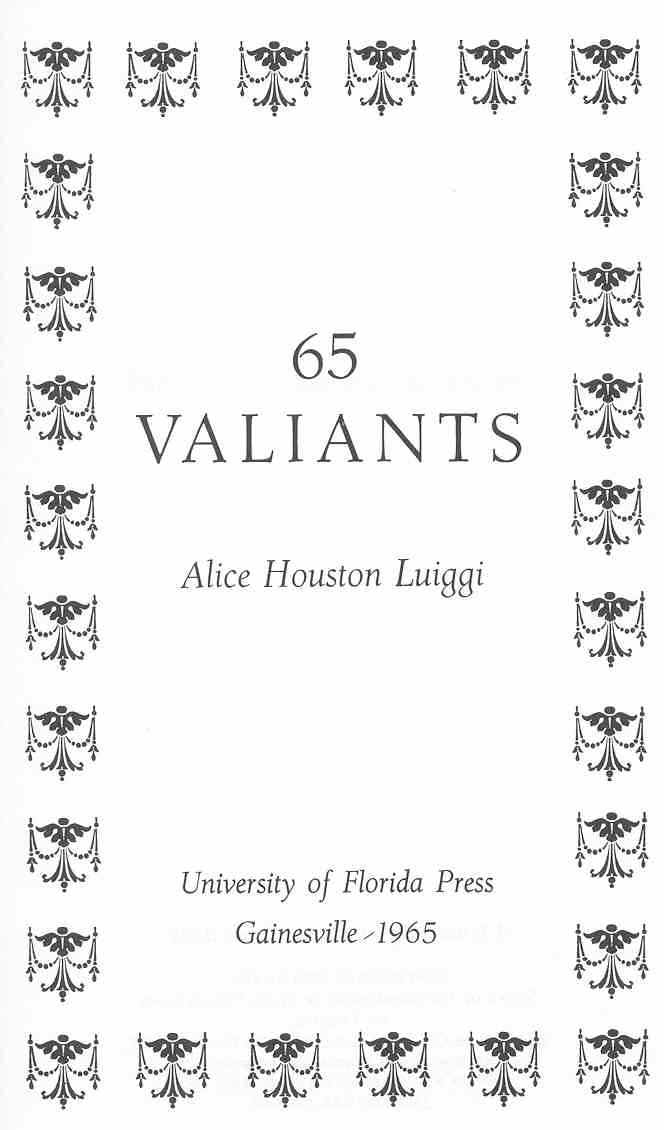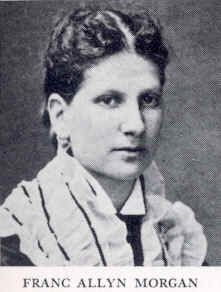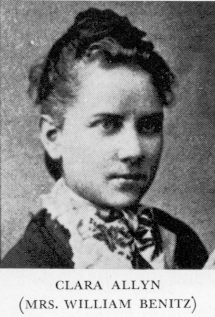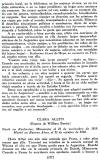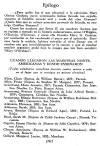ABOUT THE AUTHOR
A noted publicist and humanitarian, Alice Houston Luiggi (1886-1963),
contributed numerous articles to Travel, House and Garden, American Home, This Week,
and similar publications. During World War II she was in charge of radio broadcasting for
the Office of Civilian Defense in Detroit. She traveled throughout the world with her
husband, a distinguished engineer, and, in her own words, “tried to be useful in
every country I've lived in.” Sixty-five Valiants was inspired by her
challenging experiences in Argentina, where she first learned of the vital role of the
“sixty-five valiants” in establishing the educational system there. For a year
and a half she visited normal schools, examined authoritative newspapers and periodicals,
studied the official records, interviewed dozens of the “valiants’ ” associates,
pupils, and descendants, and evaluated many of the schools they had founded.
Excerpts:
- Pages 50-51: Why did they go?
- Page 67-68: Forty-Five Years of Hard Work
- Page 68: Argentina's Reaction
- Pages 98: Franc Allyn Morgan
- Pages 100: Clara Allyn Benitz
- Page 170: Franc's trip to Chile
- Various short excerpts
C. 7 The Teachers: WHY DID THEY GO?
In the days before airlines and motorships,
radio and radar, and go-now-pay-later packaged tours made traveling as carefree as staying
at home, what could have induced these gently broughtup women and girls to leave
comfortable homes and good jobs for the unknown? And having finished their three-year
contracts, what possessed them to stay longer in Argentina? - for stay most of them did.
Of the sixty-five, thirty-six stayed beyond the contract time, and taught an average of
thirteen years. Sixteen left at the end of the three-year contract; two married, with the
consent and good wishes of the department of education, before their contracts were
completed; five died within a year of arriving; and twenty lived out their lives in
Argentina.
Not for lack of good jobs in the United
States did these teachers go. In 1869 a regent of the Albany normal school wrote to Henry
Barnard, “We are in jumping want of a principal of this school.” Similar places
were open throughout the rapidly expanding West. When Mary Olstine Graham sailed with
other teachers in June, 1879, the New England Journal of Education protested
bitterly that good teachers were being induced to go abroad.
So far as their motives for going can be
unraveled - and when are motives ever simple and unmixed? - some were attracted by
salaries that on their contracts seemed high; some by the prospect of less competition and
quicker advancement than at home; some by a spirit of adventure. Clara Allyn and
Clara Gillies and Jennie Howard - and who else, perhaps? - went to find what a change of
scene might do for lacerated hearts. Isabel and Anna Dudley hoped to earn enough to lift
the mortgage from their mother's home. Jeanette Stevens, a convert to Catholicism, wished
to live in an entirely Roman Catholic country.
Some, Mary Conway waspishly wrote her sister,
came to find husbands. “They spend their entire salaries on dress and thus have a
decided advantage over the women of the country, who although they are rich in silks and
real laces, lack that peculiar style which is so distinctively American and is very
charming. What with dress, cosmetics and jewelry, the North American teachers have
completely captivated the minister of education, the native ladies say. It's easily done
for he isn't over bright.” Perhaps her ill humor arose from the fact that a husband
to her taste had never presented himself, while six of her colleagues had already married
well-to-do British or North American residents. None married Argentines.
Whatever had been their motives for going,
when they saw the utterly virgin field to work in and the gratitude of students and
parents for efforts that would be taken for granted in the United States, they were
stimulated to use every skill and talent and every bit of knowledge they possessed.
Schools grew faster than they could be staffed and the teachers were always overworked.
None ever refused regular or extracurricular activities, no matter how heavy the job
became. Though Elizabeth Coolidge early wrote in the New England Journal of Education
the gloomy warning that “sincere and earnest work rarely meets with encouragement and
often its only visible result is the imposition of more work and the reduction of
salary,” that did not slow down Franc Allyn in Paraná, who (Sara Figueroa
says) “taught at all hours.” Even on Sunday mornings, strict Methodist though
she was, Franc held a discussion meeting to air topics uppermost in the minds of her
students. Her reward? Fifty years later she wrote to her daughter, “I am so thankful
for my experience in going to Argentina.”
C.7 The Teachers: FORTY-FIVE YEARS OF HARD WORK
In her notes for the Winona Semi-Centennial
in 1915, Franc Allyn said of the work of the twenty-two teachers who had gone from
Minnesota: “Their schools created for the Argentine girl new aims, ambitions, and
ideals of life. They awoke to intellectual life and vigor. Many have become teachers and
are not only self-supporting but support entire families. Some have taken a University
course and have devoted themselves to music and literature. One has gained fame as a
sculptress, one of her works adorning a fountain in Buenos Aires.”
In the far Andean provinces, by the
wide waters of the Paraná, in the tropical north and in the wilder south, the normal
graduate is found testifying to the results of the planting of seed by North American
teachers during the past thirty-five years .... Many of the young men graduates in all
parts of the country are teaching, writing, many of them physicians, lawyers, all
testifying by the fine quality of their service and their success to the high ideals and
aims set before them in their normal school life and training.
Since the institutions of higher learning in
Argentina are the universities, now open but long closed to women, and the normal schools,
these latter have held an all-important place in the education and the affections of
Argentine women. The Escuela Normal de Clara Armstrong and the Escuela Normal de Mary
Graham, as well as those of La Rioja and Mendoza and Goya, and all the others, mean to the
Argentine girl what Smith and Vassar and Wellesley - and the hundreds of denominational
and nonsectarian colleges, the normal schools, state colleges, and universities across the
plains and mountains to Mills and Pomona and Occidental - signify to her North American
counterpart.
C.7 The Teachers: ARGENTINA'S REACTION
Out of one hundred Argentines in 1870 only
twenty could read and write, the census showed. Twenty-five years later the percentage had
leaped to fifty. “This is the work of the normal schools, of which not one existed in
1869,” wrote José B. Zubiaur, minister of education.
Sixty-five North American teachers, invited
by the Argentine government between 1869 and 1898, had founded or rehabilitated eighteen
normal schools, each with its model grade school and kindergarten in which normal-school
students could observe and practice modern methods of teaching.
....
José Torres, who succeeded George Stearns at
Paraná was emphatic in his report of 1885: “Although normal schools have existed
only fourteen years in Argentina, their influence on the common schools is notable ...
they not only turn out excellent teachers . . . more, through their model schools they
improve the education of the children of each town where they are situated.”
To Franc Allyn Morgan,
Torres wrote: “Every day I am more and more grateful to you and Professor Phelps for
the very fortunate selection of distinguished teachers. All are excellent not only for
their qualifications of character but also for their ability and intelligence. My desire
to procure new teachers from the United States has been more than realized. Those whom
Miss Armstrong selected are also very good. With the addition of these new teachers, the
normal schools have received a great impetus and are on the road of progress.”
Maximo Victoria, the third head of
the Paraná school, himself a pupil of the North American teachers, insisted, “The
objectives which President Sarmiento, with his far-seeing prevision, set forth for the
Paraná school, it has filled with greatest amplitude.”
C.9: Hijas de Sarmiento: FRANC ALLYN
To her schoolmate Franc Allyn, Susan Wade handed the torch as head of the model grade school at
Paraná when she went home in 1877 at the end of her three-year contract. Franc had
graduated from the Winona normal school six years before, and had been busy keeping a home
for her widowed father in Rochester, Minnesota, being a mother to her little sister Clara,
and teaching in Rochester grade schools. Among her pupils were two bright and sometimes
mischievous playmates of Clara's -Willie and Charlie Mayo. Hers had been a serious life
since her mother died when Franc was only ten, and it was a great adventure to embark on
the luxury liner City of Berlin for Liverpool at the beginning of 1877.
Not for longer than the boat
trip was she able to live in comfortable idleness - not when people around her needed
anything she could do - and she found plenty to do in Paraná. She was a complete
extrovert, always happiest in the company of others, doing something for them, preferably
with a child on her knees, says her daughter. The job at Paraná called for all her skills
of which she had many, and she threw all her wiry, ninety-five pounds into her tasks.
Sara Figueroa writes that she
“taught at all hours,” and when she left Argentina, the head of the Paraná
school said: “The North American normal profesora, Miss F. Allyn, has
fulfilled her contract, and I, for love of Argentina, desire fervently that every person
who comes into this country to lend any service will fulfill his or her contract as has
this most estimable young lady.” One Argentine pupil, Señora Rita Lallatada de
Victoria, long fondly remembered the Sunday morning discussion hour that Franc Allyn
headed, when students brought up problems that could not be covered in classrooms, with
free discussion and criticism. “Of all the teachers,” she recalled, “the
nicest and prettiest was Miss Franc Allyn.” She was not actually a beauty, her
daughter thinks, but with gray-green eyes and light-brown hair, and alive in every fiber,
she was winsome and lovable.
An attractive
twenty-one-year-old cousin of Franc's came from Minnesota to pass five months with her at
the end of her contract in 1881. “The school is very nice,” the visitor wrote in
her carefully kept journal, “and they evidently appreciate and prize Franc . . . .
The examinations lasted through five evenings. The gymnastics were very pretty; boys one
night in blue and white Louis XV suits; little girls in pale blue, pink and scarlet and
white, with their wands, bells, etc., tied with ribbons to match. Everything went off well
and I was very proud of Franc's work and success .... The day we left crowds of people saw
her off. She received puddings, cakes, and flowers in abundance .... At the last I was
afraid Franc would break down but she did not.” [WebNote: More of Harriet Packard's
diary entries are available at the foot of this web-page.]
Six happy months the cousins
spent sightseeing in Europe, then Franc went back to teach in Winona. Within a year she
married Stephen Morgan, a well-established jeweler of Winona, a widower with nearly grown
children. She was as devoted to them as to her own boy and girl who came along soon, and
her daughter says that the stepchildren turned to Franc as readily as her own children
did.
Her life was typical of that
of active and intelligent women who have made Main Streets in their Minnesota towns, or
towns of other states, places that American soldiers over the globe remember with longing.
With a highly informal approach, Franc served wherever she was needed, whether giving a
hand in the Winona normal school that had meant so much in her life, in the local grade
schools, the library, civic betterment, or cultural clubs, or in her favorite, a home for
elderly people not eligible for public relief. Her greatest contribution, perhaps, was in
her day-to-day contact with people - stimulating them, giving them heart, liking them. Her
friends were always amused at the fact that in travels around the world with her husband,
he described the political set-up, economic status, architecture, or scenery, while Franc
wrote or spoke with fervid interest and sympathy and skill about the people whom she
encountered.
Through her comfortable and
well-staffed house a stream of long staying guests flowed: nieces from Argentina who
needed schooling; old friends and, equally welcome, the children of old friends; a student
struggling through school; a lonesome young teacher or businessman away from home.
Katharine Grant Hope, her successor at Paraná, passed months with her.
“She got younger as she
got older,” her daughter said. As a girl, her strict Methodist training had made
dancing unthinkable, but at eighty her great joy was to go to the country club and watch
her grandchildren dance.
At eighty-one she started to
burn accumulated letters, but put them aside. “I might want to read them when I get
old,” she said. Her engagement book reads like that of a particularly active
debutante, and to the last she made yearly visits across the United States.
“I am so thankful for my
experience in going to the Argentine,” she wrote her daughter in an anniversary
letter reviewing her life. “And I have always had so much to be thankful for,, the
many blessings that have come to me all these years . . . such a good husband . . . such a
nice home with a good income . . . and my dear children and grandchildren, all of help and comfort.”
C.9: Hijas de Sarmiento: CLARA ALLYN BENITZ
Clara Allyn
was even tinier than Franc, and eight years younger. She finished at the Winona normal
school just as Franc was sailing for Argentina, and she taught for a year in the grade
schools of Duluth, Minnesota. When Franc was granted an assistant in the Paraná school,
she sent for Clara, who was not in the least unwilling to go, for her twenty-three year
heart was lacerated by a romance that had gone wrong.
On the river steamer from Buenos Aires to Rosario,
where Franc was coming to meet her, she saw standing at the rail a lean and tanned young
man with a poncho thrown about his shoulders. The dropping sun was turning his curly beard
and fair hair to golden. “He looks like pictures of Christ,” she murmured to
herself in awe.
Franc had written that Clara was to go to the house of
the Reverend Thomas Wood, the Methodist pastor in Rosario [WebNote: also US Consul],
whose kindly wife often sheltered North American girls, since Argentine convention did not
permit them to go alone to hotels. Mrs. Wood had invited a group of young people to meet
the sister of her favorite Franc, and one of the guests was the picturesque young man of
the boat, William Benitz. He was the son of a North American estanciero who had
been associated in California with Captain Sutter - at his sawmill, gold was discovered in
1848 - and emigrated to Argentina and bought and stocked the estancia “La
California” near Rosario.
When the
second year of Clara's contract was finished and she confided to Franc that she and young
Benitz were planning to be married, Franc in alarm packed her off to Corsicana, Texas,
where their father was living. [WebNote: Per family lore, he was postmaster; brother was a banker, later mayor.]
“I don't know enough about men to judge whether he is suitable,” the older
sister insisted. “If he is serious, he can go up and talk to father.” He was
serious and he went, and on April 25, 1881, they were married in Corsicana, eventually
going back to “La California.” Until 1962 this estancia remained in the
Benitz family. [WebNote: It still remains in the family. April
2000 it was the site of the Benitz-2000 family gathering. A grandson
of Clara still lives there today with his family.]
Clara Allyn's contribution to Argentina was not in
years of teaching but in giving it useful citizens. Eight children she had, her oldest son
an aviator did not return from World War I.
The house, which stood three miles back from the
front gate, was always open to Argentine and North American friends. Life was lived on
horseback, and rodeos, deer hunts, polo games, and gallops to neighboring estancias several
leagues away were frequent diversions. Distances were so great that they were reckoned by
leagues - three miles - and are to this day. Photographs of Clara on horseback in the
palm-bordered driveway, with her blond-haired troop of children ranged alongside her on
their ponies, make her look like the sweet-faced head of a royal family. Happily she lived
out her life at “La California”, and on it in 1930 she was buried.
C.15: The Twelve who Died: FRANC'S TRIP TO CHILE
During the summer holiday of 1878, Miss Nyman, Sarah Boyd, and Franc Allyn went over
the Andes in a mule train to Santiago and Valparaiso. During the steep climbs when they
had to walk most of the way, they developed such ravenous appetites that they could eat
with relish, even though the peon who roasted meat over the campfire at mealtime tidily
wiped his knife on the mule's tail before cutting the bread.
After the trip Miss Nyman was suddenly seized with
violent headaches and became demented. No doctor in Mendoza could say what was the matter,
and Franc Allyn decided to take her to Rosario to English-speaking doctors. During the
four hundred miles by stagecoach, Miss Nyman, a robust woman, was disturbed and restless,
but so great was her affection for tiny Franc and so complete her trust, that her little
friend was able to take her safely on the long trip. A brain tumor was found after her
death, which came within the month.
Other Notes
(p.52) $100-150 gold pesos fuertes / month,
initially more than a dollar subsequent devaluation of the dollar to 0.78 in 1870. Living
conditions were expensive (rent was $35 / month). Return fare to the US was included.
(p.64) “Few trains were equipped with
toilets, and Franc Allyn recalled that at long intervals the train
stopped on the shrubless short-grass plains, men scattering to one side, women to the
other.”
(p.142-143) Bernice Avery's home in
Rochester, MN, was “like a home to the motherless Allyn girls.”
Bernice married Richard Agar at “La California”, 19 Jan.1886.
[WebNote: Clara's son, William Agar Benitz, was named after Richard Agar, of Agar, Cross
& Co., well known providers in Argentina of farm equipment & supplies, e.g. the
many Aermotor windmills which still dot the countryside today.]
May Watt de Mohr-Bell (nieta de
Clara) muy amablemente nos hizo copias de la versión impreso en la Argentina.
LA NIÑA... FRANC ALLYN
(Esposa de Stephen W. Morgan)
Nació en 1851. Murió en Winona, Minnesota, en 1933.
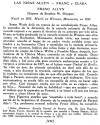
Susan Wade dejó en manos de su condiscípula Franc Allyn, la antorcha de
la dirección de la escuela primaria de Paraná, cuando regresó a su
patria el término de su contrato por tres años. Franc se había
graduado en la escuela normal de Winona seis años antes; en Rochester,
Minnesota, donde vivía, sus tareas eran grandes: atendía el hogar de su
padre viudo, cuidaba como una madre a su hermanita Clara y enseñaba en
la escuela primaria. Entre sus alumnos, habían dos niños listos y
algo traviesos, compañeros de juegos de Clara: Willie y Frankie Mayo,
depués fundadores de la Clínica Mayo, conocida en todo el mundo.
Duro había sido su vida desde la muerte de su madre, cuando contaba diez
años, y fué para ella gran aventura embarcarse rumbo Liverpool, a
principios de 1877, en el lujoso vapor Ciudad de Berlín. Su vida
en éste, de cómoda ociosidad, no duró más allá de su viaje, y aún
durante la travesía, siempre que alguno de los que la rodeaba no
necesitara algo en que ella pudiera ser útil. Cuando llegó a
Paraná, encontró una gran tarea a qué dedicarse. Era muy
comunicativa, se sentía feliz en compañía de otros, en hacer algo por
ellos. Casi seimpre estaba con un niño e su regazo - dice su
hija -. Necesitó de toda su habilidad - que era mucha -, para el
trabajo que le esperaba en Paraná, y se lanzó a él con sus tensas
noventa y cinco libras de peso [43 kg.].
Sara Figueroa escribe que “enseñaba a toda hora”, y cuando partió de la
Argentina, el director de la escuela normal de Paraná dijo (3): “La
profesora normal señorita Franc Allyn, ha cumplido
(3) Datos Históricos, Escuela Normal de Paraná, pág. 98, Sara
Figueroa. José María Torres, director de la escuela, que sucedió a
George Sterns, dedicó entusiastas elogios a la actitud de Franc y a la
obra que realizó. (Informe del año 1880, correspondiente al curso
escolar de 1879.)
[114]
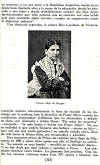
Frances Allyn
de Morgan
su contrato; y yo, por amor a la República Argentina, donde sirvo desde
hace dieciséis años a la causa de la educación, donde he educado a mis
hijos y donde probablemente acabaré mis días, deseo fervicientemente que
toda persona que se contrate con este noble país para prestarle algún
servicio, cumpla su compromiso como la dignísima señorita”.
Una discípula
argentina, la señora Rita Latallada de Victoria, recuerda todavía
afectuosamente la hora de reunión de los domingos por la mañana, bajo la
dirección de Franc Allyn, cuando los estudiantes presentaban problemas
que no alcanzaban a debatir en clase, con discusión y crítica libres.
“De todas las maestras” - recuerda - “la más buena y bonita era Franc
Allyn”. No era en realidad lo que podría llamarse una belleza -
piensa su hija -, pero sus ojos verde agrisados y su cabello castaño
claro, llena de vida hasta la última fibra, era encantadora y adorable.
Una atrayente
prima de Franc, de veintiún años, llegó de Minnesota en 1881 a pasar
cinco meses con ella, el finalizar su contrato. “La escuela es muy
bonita” - escribió en su detallado diario - “y no hay duda de que aquí
valoran y aprecian a Franc... Los exámenes duraron cinco tardes.
La gímnasia fué preciosa. Una noche los varones vistieron trajes
Luis XV azules y blancos; las
[115]
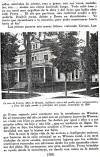
La casa de Frances Allyn de
Morgan, residencia típica del medio oeste norteamericano a fines del
siglo pasado y principios del actual. Construida en 1900.
niñas, ataviadas de celeste, rosa y grama, con sus varas, cascabeles, etc....,
atados con cintas haciendo juego. Todo salió bien y yo me sentí
muy orgullosa de la obra y del éxito que habia obtenido Franc...
El día que partimos, una multitud acudió a despedirla. Recibió
tortas, dulces y flores en abundancia... Yo temía que sucumbiera a la
emoción, pero pudo mantenerse fuerte hasta el fin” (4).
Las primas pasaron seis meses felices, visitando Europa. Luego Franc regresó, para
continuar con la enseñanza en Winona. En el transcurso del año, se
casó con un próspero joyero de Winona, un viudo con hijos ya grandes.
Se dedicó por igual a ellos y sus propios niños, un hijo y una hija, que
no tardaron en llegar. Según dice su hija, los hijastros acudían a
Franc con la misma naturalidad con que lo hacían sus hijos.
Era la suya la
típica vida de las activas e inteligentes mujeres, que hicieron de la
calle principal en su Winona natal, o en otras ciudades de otros
estados, encantadores lugares que los soldados americanos recuerdan con
añoranza desde los más apartados rincones del globo. Sin
ceremonias, con gran sencillez, Franc brindaba su ayuda donde la
necesitaran, ya dando una mano en la escuela
(4) Hay mas entradas del
diario de Harriet Packard al fondo de esta pagina de web.
[116]
primaria local, en la biblioteca, en las mejoras cívicas, ya en los clubs
culturales, o en su lugar predilecto: un hogar para ancianos sin
recursos. Su mayor aporte, tal vez, estaba en su contacto diario
con las gentes, esimulándolas, reconfortándolas, brindándoles su
simpatía. Sus amigos siempre se divertían con las crónicas de sus
viajes por todo el mundo, acompañando a su marido. Mientras él
describía situaciones políticas o económicas, obras de arquitectura o
paisajes, Franc escribía o hablaba con fervoroso interés, simpatía y
habilidad, sobre la gente que encontraba.
A su comfortable y bien servida casa, afluía una corriente de huéspedes que
permanecían en ella durante largas temporadas: sobrinas de la Argentina
que necesitaban educarse el las escuelas norteamericanas, viejos amigos,
y, los predilectos, los niños de los viejos amigos - un estudiante que
debatía en sus estudios, un joven maestro o un hombre de negocio,
solitarios, con nostalgias del lejano lugar -. Katherine Grant de
Hope, su succesora en Paraná, pasaba meses con ella.
“Cuanto más
vieja, más joven parecía” - decía su hija -. Cuando era muchacha,
su severa foramación metodista le impedia pensar siquiera en el baile,
pero a los ochenta años, su gran placer era ir al club campestre a ver
bailar sus nietos.
A los ochenta y
un años empezó a quemar las cartas que había conservado, pero las apartó
en seguida. “Podría querer releerlas cuando sea vieja” - dijo -.
Su agenda era como la de una jovencita en plena actividad, y hasta el
fin de us vida realizó viajes anuales a través de los Estados Unidos.
“Estoy tan
agradecída a la experiencia que adquirí cuando estuve en la Argentina” -
escribió a su hija, rememorando su vida, en la carta que le envió para
un aniversario-. “Y tendré que agredecer siempre por tantas
bendiciones como me han sido acordadas todos estos años... un marido tan
bueno... un hogar encantador, una posición desahogada... y mis queridos
hijos y nietos, mi orgullo y mi consuelo”.
(Esposa de William Benitz)
Nació en Rochester, Minnesota, el 23 de noviembre, 1859.
Murió en Buenos Aires, el 12 de octubre de 1930.
Clara Allyn era
aún mas menuda que Franc, y ocho años menor que ella. Terminó sus
estudios en la escuela normal de Winona el año en que Franc partía para
la Argentina. Enseñó durante un año en la escuela primaria de
Duluth, Minnesota. Cuando a Franc le acordaron un ayudante, mandó
a buscar a
[117]
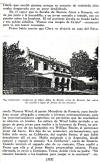
“La California”, residencia de
Clara Allyn de Benitz, cerca de Rosario, fué centro de reunión y lugar
de fiestas de las maestras
Clara, que acudió gustosa, porque su corazón de veintitrés años estaba
desgarrado por un amor desdichado.
En el vapor que la llevaba de Buenos Aires a Rosario, vió de pie junto a la barandilla,
a un joven cenceño y tostado, con un poncho sobre los hombros. El
sol poniente doraba su rizada barba y sus rubíos cabellos. “Parece
una imagen de Cristo” - murmuró para sí, con temor reverente.
Franc había
escrito que Clara se alojaría en casa del Reverendo Thomas Wood, el
pastor Metodista de Rosario (5), cuya bondadosa mujer albergaba a menudo
jóvenes norteamericanas, pues los convencionalismos argentinos no
permitían que las muchachas se alojaran en hoteles. La señora de
Wood había invitado a un grupo de gente joven para recibir a la hermana
de Franc, su predilecta, y uno de los huéspedes era William Benitz, el
pintoresco joven del barco. Era hijo de un estanciero
norteamericano, que había sido socio , en California, del capitán
Sutter, el que había descubierto allí el oro. Había emigrado a la
Argentina, donde compró y equipó la estancia “La California”, cerca de
Rosario. Cuando terminó el segundo año de su contrato, Clara
confió a Franc que ella y el joven Benitz proyectaban casarse.
Franc, alarmada, la envió a Corsicana, Texas, donde vivía su padre (6).
“No conozco bastante a los hombres para juzgar si te conviene” -
(5) Además, cónsul estadounidense
en Rosario.
(6) Según anécdotas de la
familia, era jéfe del sucursal de corréo.
[118]
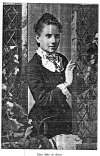
Clara Allyn
de Benitz
[119]
insistía la hermana mayor -. “Si es persona seria, puede partir y hablar
con nuestro padre”.
Era persona
seria, y partió y el 25 de abril de 1881 se casaron en Corsicana,
regresando al fin a "La California". Un hijo vive allí todavía
(7).
La contribución
de Clara Allyn a la Argentina, no se computa en años de enseñanza, sino
en los ciudadanos útiles que le dió. Tuvo ocho hijos, el menor un
aviador que no regresó de la primera Guerra Mundial.
La casa, que se
levantaba tres millas más adentro del portón de entrada, estaba siempre
abierta para los amigos argentinos y norteamericanos. La vida
transcurría a caballo, y los rodeos, la cacería del ciervo, los partidos
de polo y los paseos al galope a las estancias vecinas, a varias leguas
de distancia, eran diversiones frecuentes. Las distancias eran tan
grandes, que se contaban por leguas - una legua equivale a tres millas
-, y hasta hoy lo son. Los retratos de Clara a caballo, en el
camino de acceso bordeado de palmeras, con su conjunto de rubios hijos
alineados a ambos lados, montados en sus caballitos, la muestran como
una reina amable con su real familia. Vivió feliz en “La
California”, donde fué enterrada en 1930.
(7) Hoy el que
vive en la estancia es nieto de Clara. En abril del 2000, se festejó en “La
California” la reunión de familia “Benitz-2000” para
los 125 años de estar.
[120]
Epílogo
...¿Pero quién fue el que rebautizó a la calvinista Mary Olstine Graham, cuyos
antepasados habían llevado tan orgullosamente el faldellín escocés azul
y verde del clan Graeme? ¿Quién hizo que su estirpe pareciera
provenir de Irlanda, su enemiga Católica Romana?
Como los nombres que llevan O' son nombres ilustres, que se repiten a menudo en
la historia sudamericana, como O'Higgins, O'Donoju, O'Gorman, y como
ella firmaba Mary O. Graham, por asociación se fué combiando el punto
por el apóstrofo. Escocesa hasta la médula, hubiera soreído
al oírse llamar con el nombre con que invariablemente se la conoce, y
que el escultor argentino grabó bajo el imagen que tan bien esculpió:
“Mary O'Graham”.
CUÁNDO LLEGARON LAS MAESTRAS NORTE-
AMERICANAS Y DÓNDE ENSEÑARON
(Todas estudiaron castelleno durante cuatro
meses o más,
en el lugar que se consigna en el primer
termino)
- Allyn, Clara (Esposa de William Benitz),
1878; Paraná.
- Allyn, Franc (Esposa de Stephen W.
Morgan), 1877; Paraná.
- Amstrong, Clara Jeanette, 1877; Paraná,
Catamarca, San Juan, San Nicolás, La Plata, Buenos Aires.
- Amstrong, Frances Gertrude (Esposa de John
Alfred Besler), 1879; Catamarca, Córdoba, San Nicolás.
- Armstrong, Minnie Burrowns (Esposa de William
Robinson Ridley), 1883; Catamarca, San Nicolás.
- Atkinson, Florence, 1883; San Juan.
- Atkinson, Sarah, 1883; San Juan.
- Avery, Bernice (Esposa de Richard Agar [de Agar, Cross, y Cia, importador de los molinos Aermotor -
todavia existen en el campo. Se casaron en la estancia
“La California”.]), 1883; Paraná, La Rioja.
- Boyd, Sarah M. (Esposa de Caleb Jackson Camp);
Paraná, Tucumán.
- Caprile, Emma Nicolay de (Esposa de Julio
Caprile), 1870; Buenos Aires.
- Choate, Antoinette (Esposa de William W.
Richardson), 1883; Paraná, Rosario.
- Collord, Margaret Louise, 1892; Mendoza.
[241]

Alice Houston Luiggi
Sesenta y Cinco Valientes (Sarmiento y las Maestras Norteamericanas
Editorial Ágora, B.As., 1era edición, marzo 1959.
Introducción de J. Fred Rippy,
Prof. de Historia Lat.Americana
de la Universidad de Chicago.
Julyan
Peard, a great-grandchild of Mary Gorman (the first of the teachers to arrive in 1869),
very kindly provided copies of Alice Houston Luiggi's letters and notes regarding the
Allyn sisters. Today (2000) this material is the property of Special Collections at Duke
University Libraries (Durham, North Carolina, USA). Most of Luiggi's letters are concerned with finding people or
setting up interviews. The three notes/letters which had the most interesting
Benitz-Allyn information follow:
- Interview with Hattie Watt
- Note card with Clara's stats
- Notes from the diary of Harriet Packard
Interview notes with Hattie Watt (neé Benitz):
Interview with Mrs Hattie Watts June 11 or so, 1949, daughter of Allyn, Clara.
My mother's brother lived in
Corsicana, Texas, and I think my [grand]father did. That is why she went to Corsicana to
be married.
Married April 25, 1881.
My mother was brought up in
Rochester, Minnesota, not Winona. She only went to school in Winona, to the normal.
She was a playmate of the Mayo Brothers.
(Harriet Shields I hear is going to
be away from Washington in June, July and August.)
My mother was much younger than Aunt Franc.
My aunt did everything in such a
religious way. She married a very bigoted[1] Methodist widower with one boy. Perhaps that
made her so religious.
In the early days the Argentine
girls lived indoors. They did not leave the house much. Then, only with chaperones.
Kate Grant went home before
Christmas, 1885, I think it was, to visit. I think her husband was English.
When we had no governess, my mother
used to send me to Mrs Agar, and she sent me to Miss Armstrong's school down town. Maria
Suarez taught in the school. The teaching was all in Spanish; because I could do nothing
with it, I was very unhappy. It was a big school. I remember Mrs Besler sitting out in the
patio and singing with us.
When she had the American school,
English speaking, in Flores, I went there. It was in a large quinta that belonged to some
English people who had gone bankrupt.
Mrs Bischoff had to come back here
because she was on pension.
The address of Mrs Balfour is San
Eduardo, F.C.C.A.
My father managed one of the Hope
estancias, when they were first married.
As I recall her, Mrs Hope was a fat
woman. The picture in the Parana normal school books looks like her.
WebNotes
(1) In summary notes, 'bigoted'
was circled and marked with a 'No', in other notes it was replaced with the politer 'devoted'.
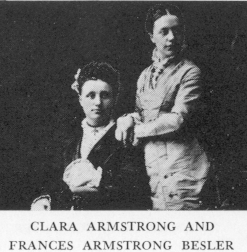
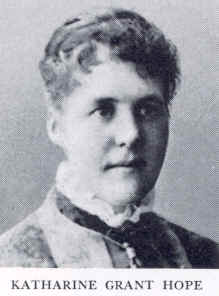
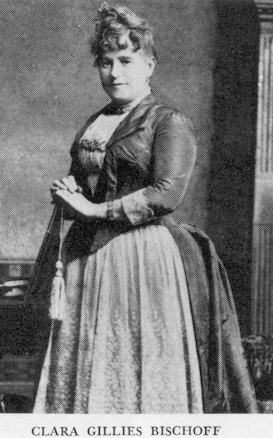
Note card with Clara's stats:
ALLYN, Clara
Born 1859 Nov 23, Rochester, Minnesota
Died 1930 October 12, Rosario
graduated from Winona January 1877
taught Duluth, Minnesota; appointed at $1200, NE Journal Ed 1879,p 236
came in late 1878 to Argentina
1879, Jan 27, appointed assistant to Franc Allyn at Parana
1881, returned to US
1881, April 25, married to Wm Benitz at Corsicana, Texas
had eight children; one son a flyer, killed in World War I
husband at first managed a Hope estancia
Later, "Landa" at Guaylaygachu
Later, inherited father's estancia "La
California", Estacion "La California", F.C.C.A. near Rosario
She is buried on the estancia
Notes from the diary of Harriet Packard:
ALLYN, Franc
Diary of Harriet Packard, 21 year old
cousin of Franc Allyn, who came to the Argentine to go back with Franc, six months in
Europe.
July 31, 1881. Franc has come to Rosario. I
tell her she has grown Spanish ... At 3 O'clock we left for Paraná[1]. Met "Miss
Allyn's Captain Morse" as he is called. His admiration is very evident ... At five
the next morning August 1 we reached Paraná. Waited for the tram ... the port is down on
the level ground but the town lies some distance off and above ... After a bowl of bread
and milk (our regular morning meal) went up to the school with Franc where I was
introduced to any number of Spanish. Anyone would suppose I was a show or curiosity of
some kind, the way I am looked at (She was a very pretty girl)
The school is very nice as far as I can judge. They evidently appreciate and prize Franc.
A very pretty custom here is sending
flowers to strangers. The violets are beautiful and a tray has been sent me covered with
beautiful bunches of violets and pretty green. Also on anyone's birthday or anniversary
what ever is sent them. It is very prettily tied up with ribbons and flowers and on a tray
covered with lace, and the servants who take it receive money according to the value of
the present they take.
We have no Sabbath except what we make
ourselves. Mrs. Borges and Mrs. Suarez have their service with the children, in which we
join.
About Oct 1. I came here to "La California" alone in charge of the Captain, a journey
of only a few hours, but a native young lady could not have done such a thing ... The next
day took the train for Cañada[2] de Gomez. ... After Cañada, the road (we went in a
trap) is one straight line for nearly twenty-five miles with not a tree and only one small
house ... All level ... At last we reached the big gate, and were through and on his land,
but the house was a league off ... Clara's rooms are very pretty, the rest of the house is
plain but very comfortable ... We eat strawberries by the soup plate instead of by the
saucer ... The longest ride I have taken was over four leagues; we went to chase deer -
Clara, three men and myself,
One morning we rode over to Las Rosas to a
service held by the Bishop ... I met a great many of the camp people and find them very
nice. This is considered the best society in the camps around here. Mostly English,
however...
I have helped chase cattle, have been out
on the rodeo with them, seen them lasoo and mark,.. Their peons' live in quarters by
themselves with a woman to cook. They receive meat, maize, mate and sugar each week and
their wages are almost nothing.
Rosario, November ... The morning before,
we left Miss Cross, one of the teachers came; also Miss Armstrong. The latter objected to
my using South American terms, in a very funny way. She says an estancia is a farm, a
patio a courtyard ... Franc is busy from morning till night on her school work. I am
thankful it will soon be over ... Mr. Torres gave a very elegant dinner party for Franc...
The examinations lasted through five
evenings ... The gymnastics were very pretty; boys one night in blue and white Louis XV
suits little girls in pale blue, pink and scarlet and white, with their wands, bells, etc,
tied with ribbons to match. Everything went off well and I was very proud of Franc's work
and success.
WebNotes
[1] Corrected spelling of Paraná.
[2] Corrected spelling of Cañada de Gomez.
[3] Harriet Packard, nicknamed 'Hattie', was the namesake of Clara's first child: Hattie Benitz.


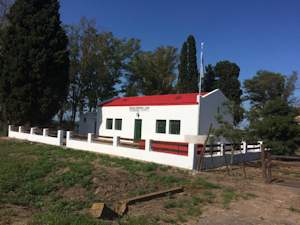 The 2-room primary school at the “La California” train station was dedicated in her name (c.1980).
[Now closed, it was attended by this site admin. & his brothers. It was repaired & repainted in Dec.2019.
The 2-room primary school at the “La California” train station was dedicated in her name (c.1980).
[Now closed, it was attended by this site admin. & his brothers. It was repaired & repainted in Dec.2019.